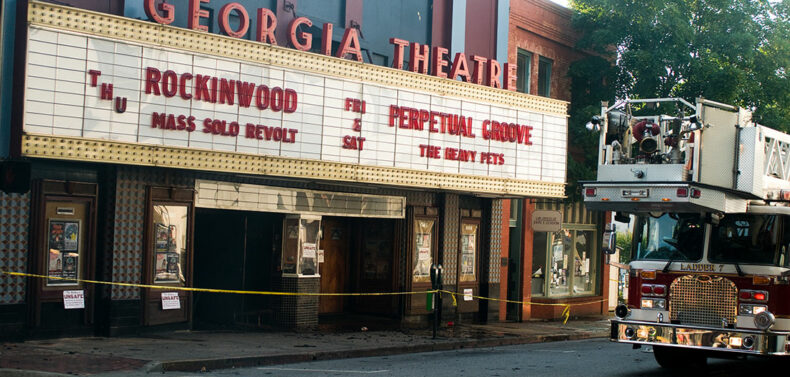Fifteen years ago Athens awoke to the news that the Georgia Theatre was on fire. Many of us still remember where we were when we heard about it. People flocked to the corner of Lumpkin and Clayton streets to witness the spectacle and say their goodbyes to the place where generations of locals had spent countless hours of their youth.
Just over two years later, the theater reopened with two weeks of sold-out shows, and the 120-something-year-old building reclaimed its place in the cultural landscape of downtown Athens. Against all odds the venue rose from the ashes, where it remains today.
The history of the building has many chapters, and most of us have our own stories of nights spent dancing and laughing on that sloped concrete floor surrounded by those old bricks and mortar. I’d like to highlight one aspect of the story that, although brief and mostly forgotten, played a pivotal role in the future of the space—namely, the shape of the building on the day before the fire.
My business partner and I bought the Georgia Theatre in 2004, and spent the five years between ‘04 and ‘09 slowly repairing and improving the building. At the beginning of our tenure the theater suffered from a great deal of neglect and from decades of being beaten up by concert goers and the elements. The roof leaked, the ceiling was a hodgepodge of stained and missing acoustic tiles, the balcony seating was disgusting, the bathrooms were barely functional, the curtains were tattered, the smell reeked, the staff was disgruntled, the marquee was missing bulbs and ballasts—the place was a mess. The reputation of the theater was, of course, also suffering. Many Athenians refused to come to shows because of the deterioration and inherent discomfort inside. Our mission was to win back the hearts of the community by restoring the grandeur of the old Art Deco building to the best of our abilities.
By the spring of ‘09, things were finally shaping up. We had stopped the majority of the leaks and installed new balcony seating, new curtains, a new soundboard, a fully functioning marquee and, most importantly, new bathrooms. The stained and dull creamy exterior was painted with vibrant colors, the smell was tolerable, and the staff was invigorated with fresh momentum. The final year of the “old Theatre” was packed with great shows. Audiences and bands alike were starting to notice the cumulative effect of the improvements.
Then in the early morning hours of June 19, 2009, the place caught on fire and was completely gutted by flames. To me, one of the greatest tragedies of that day remains the fact that many peoples’ memories of the pre-fire building were of the space at its worst, just a few years before. The wear and tear of a concert hall is an unstoppable force which requires dedication and creative thinking to combat. Restoring that old building was an uphill battle that required time and money, and oftentimes meant fixing problems that most people weren’t even aware of in the first place. We had a limited budget and had to work around the busy calendar, but the positive momentum fed on itself. Plumbers, electricians, even the exterminator were happy to join in this gradual revival, and after five years the job was nearing completion. I can confidently say that the Georgia Theatre was in the best shape it had been in nearly 50 years on the day it burned, and that fact adds one more layer to the tragedy of that day. In retrospect I realize how the momentum of improvement impacted the events that occurred after the fire.
Based on previous sales, it made no financial sense to rebuild. The numbers just didn’t add up. I contrived the most optimistic spreadsheets about potential revenue and costs after rebuilding, and the sums weren’t nearly enough to cover even modest estimates of the required construction loans. However, Athenians were determined to have the Georgia Theatre back, and the momentum pulled us forward. The red tape was thick and almost impossible to untangle, but as the project progressed, the intangible positives occurred with slightly more frequency than the inevitable setbacks. Donations from the public amounted to about 5% of the total project cost, a sum that through luck and good timing enabled us to, just barely, keep the boat afloat. We repurposed charred wood; we value engineered; we made deals; we received tons of good will and loving labor until finally the building was back. We were frankly pessimistic about the financial future of the business and prepared ourselves for the real possibility that ends would not meet. But that momentum—the momentum that started with years of repairs, the momentum carried by fans of music, the momentum of Athens concertgoers—kept snowballing. The first month after reopening, the theater did six times what a good month was before. Bands were happy, employees were happy and, most importantly, audiences were happy. It worked! The Georgia Theatre was here to stay, again.
To those of you who remember that day 15 years ago, and who joined in the flood of goodwill, thank you. I urge you to keep in mind that the Georgia Theatre is and always has been a place for young people. This fall’s freshmen were three years old when it happened. The theater is their birthright, and you enabled them to enjoy that right by your collective generosity and participation in saving the place. To those fans of music who are too young to remember the “old Theatre” or the fire, I say cheers, and I hope you realize what a special gift you have been given by your fellow Athenians.
Wilmot Greene was the owner and manager of the Georgia Theatre from 2004–2014.
Like what you just read? Support Flagpole by making a donation today. Every dollar you give helps fund our ongoing mission to provide Athens with quality, independent journalism.






